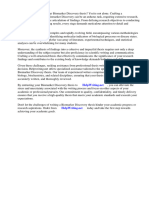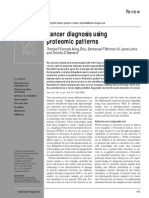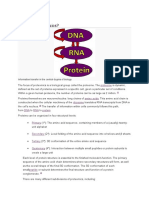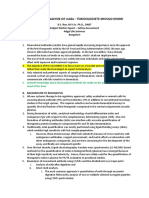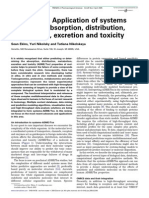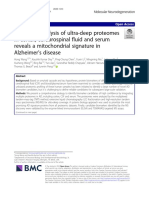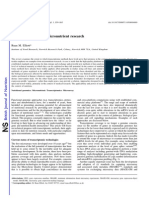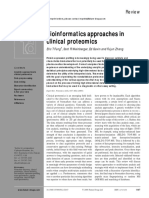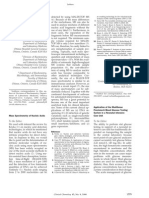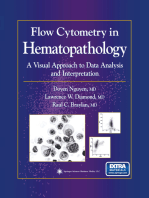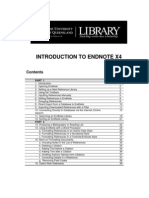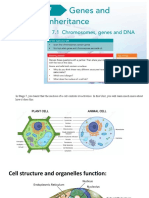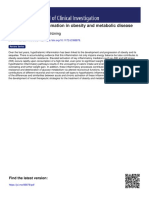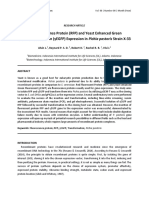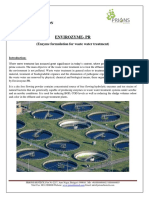Proteomics/Biomarkers: Presentation
Proteomics/Biomarkers: Presentation
Uploaded by
Nidhi JaisCopyright:
Available Formats
Proteomics/Biomarkers: Presentation
Proteomics/Biomarkers: Presentation
Uploaded by
Nidhi JaisOriginal Description:
Original Title
Copyright
Available Formats
Share this document
Did you find this document useful?
Is this content inappropriate?
Copyright:
Available Formats
Proteomics/Biomarkers: Presentation
Proteomics/Biomarkers: Presentation
Uploaded by
Nidhi JaisCopyright:
Available Formats
Proteomics/Biomarkers
Proteomics/Biomarkers
Presentation
Biomarkers
Mass spectrometry based targeted protein quantification: methods and applications [1] Main Focus
The main focus of the paper was a review of the methods and applications of using mass spectrometry to quantify proteins, especially those that are in a concentration of less than g/ml concentrations, in an attempt to universalize a procedure.
New terms
MALDI TOF/TOF matrix assisted laser desorption/ionization time-of-flight tandem mass spectrometer. Selected reaction monitoring (SRM) method in which a specific product ion from a specific parent ion is detected. All other ions with masses not specified in a predetermined range are filtered away leaving only ions with the mass in the range we are looking for. (source http:/ / en. wikipedia. org/ wiki/ Mass_chromatogram#Selected_reaction_monitoring_. 28SRM.29) Triple quadrupole type of MS that contains a linear series of three quadrupoles. The first and third set act as mass filters, and the second is a collision cell. This type of MS can filter an ion of a known mass. (source http:/ / en. wikipedia. org/wiki/Quadrupole_mass_analyzer) Hydrazide class of organic compounds that share a common functional group characterized by a N-N covalent bond with one of the constituents being an acyl group. (source http://en.wikipedia.org/wiki/Hydrazide) Biomarker biochemical feature that can be used to measure progress of the effects of treatment or a disease. (source http:/ /www.medterms.com/script/main/art.asp?articlekey=6685) For this summary, we will focus on protein biomarkers. Some diseases which have protein biomarkers that show promise as a screening tool are breast cancer, Alzheimer's, leukemia, ALS, and Parkinson's [2]. A series of six steps must be accomplished in order to successfully validate a biomarker or set of biomakers: discovery, qualification, verification, assay optimization, validation and commercialization[3]. Once a biomarker is found and accepted, it can be used to possibly predict and prevent the disease it's related to. The summary below focuses on the quantification method of proteins in the search for and identification of protein biomarkers. By finding ways in which to universally quantify proteins, one can search for all biomarkers in one screening rather than multiple screenings, once conclusive biomarkers are identified.
Proteomics/Biomarkers
Summary
With the recent breakthroughs in technology, it is conceivable that is possible to have a universal method or approach with minimal restrictions to quantitatively assay a wide number of proteins in search of potential biomarkers. Once a few potential biomarkers are discovered, further research can be done to confirm or refute its use in clinical applications. Another goal is to easily accumulate multiple detections in a single measurement. Measurements are taken by identifying synthetically stable isotopes attached to their respective proteins or peptides. Each isotope mimics the peptides endogenous counterparts allowing high selectivity. Mass spectrometry (MS) provides us with a powerful tool to compare two different protein samples. It can be used for comparing the proteome of a diseased sample against a normal sample at a global scale. This is applied to a wide array of human diseases, with the hope that it will lead to identification of biomarkers or even pathogenesis of a disease. Traditionally, ELISA [4] (enzyme-linked immunosorbent assay) has been the major method for the quantification of proteins with good sensitivity. Even today, it is the gold standard for targeted protein quantification. The major drawback with ELISA is the lack of availability of antibodies with high specificity. First attempts to determine the amount of specific proteins were done using stable isotope dilution methods and MS approximately 20 years ago, starting with atom bombardment MS and deuterium-labeled synthetic polypeptides. Advances in MS instrumentation has increased our ability to detect candidate proteins in complicated biological samples with high sensitivity. To quantify the results, introduction of a stable isotope (containing 13C or 15N, for example) to selected amino acids in a reference peptide sequence provides a peptide with the same physicochemical properties, that can be readily distinguished by MS from the peptide in the target tissue or fluid. Studies have shown that full-length proteins with stable isotopes can be used in quantification of biomarkers in urine and water samples with nanomolar and picomolar level sensitivities respectively. There is a variety of MS platforms used for quantitative proteomics, some of which are triple quadrupole [5] (triple Q), matrix assisted laser desorption/ionization time-of-flight tandem mass spectrometer (MALDI TOF/TOF [6]), electrospray ionization (ESI) based on QTOF MS, and an ion trap instrument using selective ion monitoring (SIM) mode. The most popular of the platforms above is the triple Q. Demonstrations have shown that it can multiplex and simultaneously target more than 50 peptides for quantification in plasma in a single measurement. For targeted quantitative analysis, coupling liquid chromatography with MALDI greatly enhances the performance of MALDI bases MS. Some advantages of this application include the ability of the techniques to be performed in parallel with each other, it can be made a highly selective, data-driven procedure, and the preservation of the sample to some degree for repeat analysis. This technique is also highlighted by its potential high throughput and excellent resolution. One of the most important steps in quantification is sample preparation which greatly influences sensitivity. One of the most common steps used is the depletion of highly abundant proteins making it easier to enhance analytical dynamic range and the detection of proteins in low concentrations. One of the techniques performed is strong-cation exchange chromatography (SCX) which has shown to give the ability to detect peptides in the high pg/ml level, giving a 100-fold improvement over direct plasma analysis. Post-translational modification (PTM) is an important process to understand since it is often involved in tumor progression, but can be a problem to mimic due to the complexity and structure of the sugar chains (as in glycosylation PTM). One experiment extracted N-linked glycopeptides and de-glycosylated. This resulted in the conversion of Asn to Asp and a difference in mass. This was utilized to make a synthetic polypeptide to replicate an N-linked glycopeptide in its glycosylated form. Once of the main features of MS based quantification is for clinical applications used to identify biomarkers associated with diseases. For example, 177 protein candidates associated with stroke and cardiovascular disease in plasma have been proposed. Some biomarkers affiliated with stroke are S-100b, B-type neurotrophic growth factor, von Willebrand factor and monocyte chemotactic protein-1[7]. Other biomarkers have been proposed to rheumatoid arthritis and breast cancer among others.
Proteomics/Biomarkers One of the main goals of the ability to quantify proteins and peptides is for personalized medicine. As technology advances, we will be able to create techniques that easily assemble multiples detection in a single measurement. Biomarkers from diseases can also be multiplexed in a single assay, allowing us to possibly diagnose multiple diseases. Ideally, a single-step preparation strategy is key, allowing for high throughput and possible an automated process, reducing the amount of human interaction and the chance of human error.
Relevance to Proteomics Course
The ability to quantify proteins using mass spectrometry is a great tool to compare a large number of proteins from a control sample with a test sample in search of biomarkers. When a noticeable difference is detected, further studies can be performed on those proteins. Major breakthroughs in MS technology give us the capability to universally approach developments to quantify a wide spectrum of proteins with little restriction. It also gives us the ability to make more detections per measurement. In the future, these approaches can give way to personal medicine giving us the ability to screen individuals by detecting multiple biomarkers from a single or multiple diseases.
References
[1] Pharmaceutical Outsourcing Decisions. SPG Media Limited. (http:/ / www. pharmaceuticaloutsourcing. com/ articles/pod003_014_power3.htm) [2] Rifai, Nader, Gillette, Michael A., and Carr, Steven A. "Protein biomarker discovery and validation: the long and uncertain path to clinical utility". Nature Biotechnology 24, 971 - 983 (2006) (http:/ / www. nature. com/ nbt/ journal/v24/n8/abs/nbt1235.html) [3] Reynolds, Mark A., et al. "Early Biomarkers of Stroke". Clinical Chemistry 49 (2003): 1733-1739. Print. (http:/ / www.clinchem.org/cgi/content/abstract/49/10/1733)
References
[1] [4] [5] [6] http:/ / www. ncbi. nlm. nih. gov/ pmc/ articles/ PMC2657955/ ?tool=pmcentrez http:/ / en. wikipedia. org/ wiki/ ELISA http:/ / en. wikipedia. org/ wiki/ Quadrupole_mass_analyzer#Triple_quadrupoles http:/ / en. wikipedia. org/ wiki/ MALDI-TOF#Mass_spectrometer
Article Sources and Contributors
Article Sources and Contributors
Proteomics/Biomarkers Source: http://en.wikibooks.org/w/index.php?oldid=2376411 Contributors: Ajc3445, Pac8612, Planotse, Thenub314, 1 anonymous edits
Image Sources, Licenses and Contributors
File:1leftarrow.png Source: http://en.wikibooks.org/w/index.php?title=File:1leftarrow.png License: GNU Lesser General Public License Contributors: David Vignoni File:Gohome.png Source: http://en.wikibooks.org/w/index.php?title=File:Gohome.png License: GNU Lesser General Public License Contributors: David Vignoni File:2rightarrow.png Source: http://en.wikibooks.org/w/index.php?title=File:2rightarrow.png License: GNU Lesser General Public License Contributors: David Vignoni
License
Creative Commons Attribution-Share Alike 3.0 Unported //creativecommons.org/licenses/by-sa/3.0/
You might also like
- Cell Membrane Bubble Lab - : Student AnalysisDocument3 pagesCell Membrane Bubble Lab - : Student Analysisbaekhyunwife백현부인63% (8)
- Examination Questions and Answers in Basic Anatomy and Physiology. 2000 Multiple Choice Questions - Martin CaonDocument508 pagesExamination Questions and Answers in Basic Anatomy and Physiology. 2000 Multiple Choice Questions - Martin CaonMiguel Angel Mendoza Zabalaga67% (6)
- (Bradford Books) Robert Arp - Scenario Visualization - An Evolutionary Account of Creative Problem Solving (2008, The MIT Press)Document221 pages(Bradford Books) Robert Arp - Scenario Visualization - An Evolutionary Account of Creative Problem Solving (2008, The MIT Press)Federalist EthiopiaNo ratings yet
- Biomarker Amplification by Serum Carrier Protein BindingDocument10 pagesBiomarker Amplification by Serum Carrier Protein BindingMuhdFaez-HafezMohdKipliNo ratings yet
- Biomarker Discovery ThesisDocument7 pagesBiomarker Discovery Thesiskrystalgreenglendale100% (1)
- Metabolomics in Multiple SclerosisDocument10 pagesMetabolomics in Multiple SclerosisFederico Germán EspinosaNo ratings yet
- LC-MS Metabolic Study For Disease MarkerDocument21 pagesLC-MS Metabolic Study For Disease MarkerharishkumarpogulaNo ratings yet
- Wormwood Et Al JPB 2013Document8 pagesWormwood Et Al JPB 2013LupuLoredanaNo ratings yet
- X ROTEI 3Document6 pagesX ROTEI 3api-3811432No ratings yet
- Cancer Diagnosis ÚingDocument10 pagesCancer Diagnosis ÚingnguyenhuulongNo ratings yet
- HHS Public Access: Multiplex Immunosensor Arrays For Electrochemical Detection of Cancer Biomarker ProteinsDocument31 pagesHHS Public Access: Multiplex Immunosensor Arrays For Electrochemical Detection of Cancer Biomarker ProteinswardaninurindahNo ratings yet
- Unipep - A Database For Human N-Linked Glycosites: A Resource For Biomarker DiscoveryDocument12 pagesUnipep - A Database For Human N-Linked Glycosites: A Resource For Biomarker DiscoveryChartchai ChaichanaNo ratings yet
- Technique Review Proteomics Approaches To Biomarker DetectionDocument7 pagesTechnique Review Proteomics Approaches To Biomarker DetectionNidhi JaisNo ratings yet
- Biosensors Electrochemical 2011Document20 pagesBiosensors Electrochemical 2011onynhoNo ratings yet
- Metabolomics: The Study of MetabolitesDocument19 pagesMetabolomics: The Study of MetabolitesNutan Desai RaoNo ratings yet
- Microbiological Identificationwith MALD1Document11 pagesMicrobiological Identificationwith MALD1FernandabioNo ratings yet
- Editorial: Mass Spectrometry-Based Diagnostics: The Upcoming Revolution in Disease DetectionDocument2 pagesEditorial: Mass Spectrometry-Based Diagnostics: The Upcoming Revolution in Disease DetectionCamilo PintoNo ratings yet
- Proteo MicsDocument25 pagesProteo MicsSaptarshi GhoshNo ratings yet
- Proteomics by SWATH MSDocument23 pagesProteomics by SWATH MSRenu GoelNo ratings yet
- Application of Proteomics For Discovery of Protein BiomarkersDocument9 pagesApplication of Proteomics For Discovery of Protein BiomarkersNidhi JaisNo ratings yet
- Metabolomics Thesis PDFDocument12 pagesMetabolomics Thesis PDFTiffany Daniels100% (2)
- Application of Bioinformatics in Various Fields: Ravi KapoparaDocument43 pagesApplication of Bioinformatics in Various Fields: Ravi KapoparasrashmiyadavNo ratings yet
- Immunophenotyping Techniques for Biomedical Scientists: Continuing Professional Development in Pathology For Medical Laboratory ProfessionalsFrom EverandImmunophenotyping Techniques for Biomedical Scientists: Continuing Professional Development in Pathology For Medical Laboratory ProfessionalsNo ratings yet
- Protein Microarray Naveed Up MushtaqDocument16 pagesProtein Microarray Naveed Up MushtaqAngumaniNo ratings yet
- 10.1515 - CCLM 2023 7064Document92 pages10.1515 - CCLM 2023 7064sfendri17No ratings yet
- Drug Designing, Development and BioinformaticsDocument48 pagesDrug Designing, Development and BioinformaticsBrijesh Singh YadavNo ratings yet
- Document BioinformaticsDocument10 pagesDocument Bioinformaticssourishvijay1509No ratings yet
- HPLC Methods For Quantifying Anticancer Drugs in Human SamplesDocument21 pagesHPLC Methods For Quantifying Anticancer Drugs in Human SamplessorinamotocNo ratings yet
- BASICS OF BIOANALYSIS OF Mabs - TOXICOLOGISTS SHOULD KNOWDocument4 pagesBASICS OF BIOANALYSIS OF Mabs - TOXICOLOGISTS SHOULD KNOWDhaval ShahNo ratings yet
- Techniques: Application of Systems Biology To Absorption, Distribution, Metabolism, Excretion and ToxicityDocument8 pagesTechniques: Application of Systems Biology To Absorption, Distribution, Metabolism, Excretion and Toxicityppt4056No ratings yet
- Chemerin Isoform Analysis in Human Biofluids Using An LC-MRM-MS-based Targeted Proteomics Approach With Stable Isotope-Labeled StandardDocument9 pagesChemerin Isoform Analysis in Human Biofluids Using An LC-MRM-MS-based Targeted Proteomics Approach With Stable Isotope-Labeled StandardHildaNo ratings yet
- Analysis of Plasma 3-Methoxytyramine, Normetanephrine andDocument9 pagesAnalysis of Plasma 3-Methoxytyramine, Normetanephrine andKuanNo ratings yet
- Biology Project On Ai in MedicineDocument10 pagesBiology Project On Ai in Medicinejapmansingh45678No ratings yet
- Integrated Analysis of Ultra-Deep ProteomesDocument20 pagesIntegrated Analysis of Ultra-Deep ProteomesMAURICIO FLORESNo ratings yet
- Protokol AnalizeDocument29 pagesProtokol AnalizeenaNo ratings yet
- Metabolomics in Nutrition Research Current StatusDocument5 pagesMetabolomics in Nutrition Research Current StatusmendongoliviaNo ratings yet
- Inter-Individual Differences and Common Features of Human Urine Peptidome Revealed by Liquid Chromatography-Tandem Mass SpectrometryDocument5 pagesInter-Individual Differences and Common Features of Human Urine Peptidome Revealed by Liquid Chromatography-Tandem Mass Spectrometrysyed aftab hussainNo ratings yet
- Introduction To BiomarkersDocument83 pagesIntroduction To BiomarkersSubodh NanavatiNo ratings yet
- Principles of Early Drug DiscoveryDocument11 pagesPrinciples of Early Drug DiscoveryAmrit Karmarkar RPhNo ratings yet
- 1 s2.0 S1936523320303995 MainDocument10 pages1 s2.0 S1936523320303995 MainNoman M HasanNo ratings yet
- Antibody Therapy and Cancer Treatment - Current Status AbstractDocument1 pageAntibody Therapy and Cancer Treatment - Current Status AbstractlaurakaiohNo ratings yet
- Perspective: Systems Biology of Metabolism: A Driver For Developing Personalized and Precision MedicineDocument8 pagesPerspective: Systems Biology of Metabolism: A Driver For Developing Personalized and Precision MedicineMauricio RíosNo ratings yet
- OmicsDocument6 pagesOmicskvictoNo ratings yet
- Health Biotech AssignmentDocument4 pagesHealth Biotech AssignmentHamzaNo ratings yet
- Quantitative Analysis of Therapeutic Proteins in Biological Fluids Recent Advancement in Analytical TechniquesDocument21 pagesQuantitative Analysis of Therapeutic Proteins in Biological Fluids Recent Advancement in Analytical Techniques12saoirse34No ratings yet
- Principles of Molecular Microbiology Testing MethodDocument49 pagesPrinciples of Molecular Microbiology Testing MethodADUGNA DEGEFENo ratings yet
- Transcriptomics and Micronutrient Research: Ruan M. ElliottDocument7 pagesTranscriptomics and Micronutrient Research: Ruan M. ElliottEmanuel DiegoNo ratings yet
- Editorial: 184 Combinatorial Chemistry & High Throughput Screening, 2017, Vol. 20, No. 3Document2 pagesEditorial: 184 Combinatorial Chemistry & High Throughput Screening, 2017, Vol. 20, No. 3DavidNo ratings yet
- s12884 023 06102 6Document16 pagess12884 023 06102 6VictorRojasNo ratings yet
- J Ejca 2017 12 025Document15 pagesJ Ejca 2017 12 025Denis OverlöperNo ratings yet
- Microarray Data AnalysisDocument11 pagesMicroarray Data AnalysisPavan KumarNo ratings yet
- Applying Machine Learning in Liver Disease & Transplantation: A Comprehensive ReviewDocument24 pagesApplying Machine Learning in Liver Disease & Transplantation: A Comprehensive ReviewPranavaNo ratings yet
- Bioinformatics Approaches in Clinical Proteomics: ReviewDocument16 pagesBioinformatics Approaches in Clinical Proteomics: ReviewHermeson LimaNo ratings yet
- Using Gut Microbiota As A Diagnostic Tool For Colorectal Cancer Machine Learning Techniques Reveal Promising Results CompressDocument12 pagesUsing Gut Microbiota As A Diagnostic Tool For Colorectal Cancer Machine Learning Techniques Reveal Promising Results CompressphopicsignerNo ratings yet
- Approaching Microbiological Method Validation-1Document19 pagesApproaching Microbiological Method Validation-1Apar DholakiaNo ratings yet
- Cancer BiomarkersDocument7 pagesCancer Biomarkersmaheen_aslam6596No ratings yet
- Chemical Proteomics Applied in Target Identification and Drug DiscoveryDocument3 pagesChemical Proteomics Applied in Target Identification and Drug DiscoveryFree Escort ServiceNo ratings yet
- Tumor Marker General Principles and Guidelines (S.sharma 2013)Document8 pagesTumor Marker General Principles and Guidelines (S.sharma 2013)Ria DeviNo ratings yet
- MS of NADocument2 pagesMS of NAnbkondaNo ratings yet
- Final BiomarkerDocument18 pagesFinal BiomarkerpareshtiwariNo ratings yet
- Metabolomics: Topics in Chemical Biology: Advanced ArticleDocument10 pagesMetabolomics: Topics in Chemical Biology: Advanced ArticleazzaassNo ratings yet
- Flow Cytometry in Hematopathology: A Visual Approach to Data Analysis and InterpretationFrom EverandFlow Cytometry in Hematopathology: A Visual Approach to Data Analysis and InterpretationNo ratings yet
- Biomarkers in Cancer Therapy: Liquid Biopsy Comes of AgeFrom EverandBiomarkers in Cancer Therapy: Liquid Biopsy Comes of AgeHideaki ShimadaNo ratings yet
- Commentary: Diagnosis and Classification of The Small Round-Cell Tumors of ChildhoodDocument5 pagesCommentary: Diagnosis and Classification of The Small Round-Cell Tumors of ChildhoodNidhi JaisNo ratings yet
- Lecture 10Document32 pagesLecture 10Nidhi JaisNo ratings yet
- Microwave-Assisted Protein Preparation and Enzymatic Digestion in ProteomicsDocument8 pagesMicrowave-Assisted Protein Preparation and Enzymatic Digestion in ProteomicsNidhi JaisNo ratings yet
- Metabolic Labeling of Proteins For Proteomics : Robert J. Beynon and Julie M. PrattDocument16 pagesMetabolic Labeling of Proteins For Proteomics : Robert J. Beynon and Julie M. PrattNidhi JaisNo ratings yet
- Application of Proteomics For Discovery of Protein BiomarkersDocument9 pagesApplication of Proteomics For Discovery of Protein BiomarkersNidhi JaisNo ratings yet
- Liquid Tissue™: Proteomic Profiling of Formalin-Fixed TissuesDocument4 pagesLiquid Tissue™: Proteomic Profiling of Formalin-Fixed TissuesNidhi JaisNo ratings yet
- Time To Organize The Bioinformatics Resourceome: PerspectiveDocument3 pagesTime To Organize The Bioinformatics Resourceome: PerspectiveNidhi JaisNo ratings yet
- Proteomics/Experimental Protocols: PresentationDocument2 pagesProteomics/Experimental Protocols: PresentationNidhi JaisNo ratings yet
- Functional Genomics and Proteomics As A Foundation For Systems BiologyDocument10 pagesFunctional Genomics and Proteomics As A Foundation For Systems BiologyNidhi JaisNo ratings yet
- Technique Review Proteomics Approaches To Biomarker DetectionDocument7 pagesTechnique Review Proteomics Approaches To Biomarker DetectionNidhi JaisNo ratings yet
- Proteomics/Protein - Protein Interactions: PresentationDocument3 pagesProteomics/Protein - Protein Interactions: PresentationNidhi JaisNo ratings yet
- 5Document3 pages5Nidhi JaisNo ratings yet
- Proteomics/Protein Sample Preparation: PresentationDocument3 pagesProteomics/Protein Sample Preparation: PresentationNidhi JaisNo ratings yet
- Proteomics/Post-translational Modification: PresentationDocument3 pagesProteomics/Post-translational Modification: PresentationNidhi JaisNo ratings yet
- MBKHGDocument10 pagesMBKHGNidhi JaisNo ratings yet
- Intro To EndnoteX4Document40 pagesIntro To EndnoteX4AdammNo ratings yet
- Original Article: The Diagnostic Accuracy of Fine Needle Aspiration Cytology in Neck Lymphoid MassesDocument4 pagesOriginal Article: The Diagnostic Accuracy of Fine Needle Aspiration Cytology in Neck Lymphoid MassesNidhi JaisNo ratings yet
- Chevannese Ellis - Circ Class WorkDocument3 pagesChevannese Ellis - Circ Class WorkChevannese EllisNo ratings yet
- Obstetric Ultrasound - Fetal Age EstimationDocument47 pagesObstetric Ultrasound - Fetal Age EstimationMuhammad AbeeshNo ratings yet
- Bioenergetic Architecture - An Introduction PDFDocument8 pagesBioenergetic Architecture - An Introduction PDFRamanNo ratings yet
- Taxonomic Revision of Moss Families Hookeriaceae and Hypopterygiaceae in MalayaDocument48 pagesTaxonomic Revision of Moss Families Hookeriaceae and Hypopterygiaceae in MalayaCristopher Jimenez OrozcoNo ratings yet
- Weeds of Rice in Asia PDFDocument120 pagesWeeds of Rice in Asia PDFjuliNo ratings yet
- PreservationDocument25 pagesPreservationAnmol Giri L 2020 DT 05 BNo ratings yet
- Greek and Latin Roots PowerpointDocument15 pagesGreek and Latin Roots Powerpointapi-291467690No ratings yet
- Unit 7: Genes and Inheritance Lesson 7.1: Chromosomes, Genes and DNADocument44 pagesUnit 7: Genes and Inheritance Lesson 7.1: Chromosomes, Genes and DNAhypezakram100% (1)
- Hsslive Xii Zoology Vijayabheri 2024Document4 pagesHsslive Xii Zoology Vijayabheri 2024ajithaprabhath123No ratings yet
- Biomarkers For Myocardial Infarction, CVS BlockDocument13 pagesBiomarkers For Myocardial Infarction, CVS BlockGlucose DRglucoseNo ratings yet
- Jais e Bruning (2017) Hypothalamic Inflammation in Obesity and Metabolic DiseaseDocument10 pagesJais e Bruning (2017) Hypothalamic Inflammation in Obesity and Metabolic DiseaseAna Flávia SordiNo ratings yet
- BiotechnologyDocument2 pagesBiotechnologyAyessa Joy GarciaNo ratings yet
- Cancer: Kendriya Vidyalaya AruvankaduDocument20 pagesCancer: Kendriya Vidyalaya AruvankaduGáMÍNG WÍTH ÁBHÍ GaMÍNG CHÁNNÉLNo ratings yet
- 3rd Summative in Science 4-2nd QDocument2 pages3rd Summative in Science 4-2nd QERMIDA SANTOSNo ratings yet
- Republic v. Cagandahan, GR No. 166676 Sept 12, 2008Document5 pagesRepublic v. Cagandahan, GR No. 166676 Sept 12, 2008Ashley Kate PatalinjugNo ratings yet
- Review of LaboratoryDocument48 pagesReview of LaboratoryIkhar RidhoNo ratings yet
- (Main) Genetic Engineering Lab Report Part 2 - Group 2Document17 pages(Main) Genetic Engineering Lab Report Part 2 - Group 2catarina alexandriaNo ratings yet
- LEVELS OF CERVICAL LYMPHNODES (Memorial Sloan Kettering Lymph Node Levels)Document6 pagesLEVELS OF CERVICAL LYMPHNODES (Memorial Sloan Kettering Lymph Node Levels)Angelica Joy AbadNo ratings yet
- Tooth ResorptionDocument19 pagesTooth ResorptionharshNo ratings yet
- My Eassy DibetesDocument5 pagesMy Eassy DibetesSunil BhattNo ratings yet
- Dichotomous KeysDocument8 pagesDichotomous KeysTal4shinNo ratings yet
- Waste Water Treatment Enzymes Organic Envirozyme PRDocument5 pagesWaste Water Treatment Enzymes Organic Envirozyme PRManish SinghalNo ratings yet
- Els 2ND GradingDocument6 pagesEls 2ND Gradingdobi bearNo ratings yet
- Sensory Intensification in Architecture by Kamiel Van KreijDocument94 pagesSensory Intensification in Architecture by Kamiel Van KreijIris PopescuNo ratings yet
- The Role OfgeologyDocument10 pagesThe Role OfgeologyMartin GriffinNo ratings yet
- Biochemistry 4.3 Electrolytes in GIT - MendozaDocument4 pagesBiochemistry 4.3 Electrolytes in GIT - Mendozalovelots1234No ratings yet
- CU-2021 B.Sc. (General) Zoology Semester-VI Paper-DSE-B-2 QPDocument2 pagesCU-2021 B.Sc. (General) Zoology Semester-VI Paper-DSE-B-2 QPShiladitya BhattacharyaNo ratings yet




